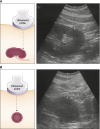Renal relevant radiology: use of ultrasound in kidney disease and nephrology procedures
- PMID: 24458082
- PMCID: PMC3913230
- DOI: 10.2215/CJN.03170313
Renal relevant radiology: use of ultrasound in kidney disease and nephrology procedures
Abstract
Ultrasound is commonly used in nephrology for diagnostic studies of the kidneys and lower urinary tract and to guide percutaneous procedures, such as insertion of hemodialysis catheters and kidney biopsy. Nephrologists must, therefore, have a thorough understanding of renal anatomy and the sonographic appearance of normal kidneys and lower urinary tract, and they must be able to recognize common abnormalities. Proper interpretation requires correlation with the clinical scenario. With the advent of affordable, portable scanners, sonography has become a procedure that can be performed by nephrologists, and both training and certification in renal ultrasonography are available.
Figures






Similar articles
-
Application of ultrasound in nephrology practice.Adv Chronic Kidney Dis. 2009 Sep;16(5):396-404. doi: 10.1053/j.ackd.2009.07.001. Adv Chronic Kidney Dis. 2009. PMID: 19695508 Review.
-
Point-of-care ultrasound in the practice of nephrology.Kidney Int. 2018 May;93(5):1052-1059. doi: 10.1016/j.kint.2017.11.032. Epub 2018 Feb 22. Kidney Int. 2018. PMID: 29477241 Review.
-
Performance of procedures by nephrologists and nephrology fellows at U.S. nephrology training programs.Clin J Am Soc Nephrol. 2008 Jul;3(4):941-7. doi: 10.2215/CJN.00490108. Epub 2008 Apr 16. Clin J Am Soc Nephrol. 2008. PMID: 18417748 Free PMC article.
-
Challenges in interventional nephrology.Contrib Nephrol. 2005;149:131-137. doi: 10.1159/000085476. Contrib Nephrol. 2005. PMID: 15876837 Review.
-
Diagnostic and Interventional Nephrology in Spain: A snapshot of current situation.J Vasc Access. 2019 Mar;20(2):140-145. doi: 10.1177/1129729818783965. Epub 2018 Jul 9. J Vasc Access. 2019. PMID: 29984611
Cited by
-
Utility of kidney ultrasonography during initial evaluation of pediatric nephrotic syndrome.Pediatr Nephrol. 2024 Feb;39(2):613-617. doi: 10.1007/s00467-023-06166-8. Epub 2023 Oct 4. Pediatr Nephrol. 2024. PMID: 37792077
-
Point-of-care ultrasound education to improve care of dialysis patients.Semin Dial. 2018 Mar;31(2):154-162. doi: 10.1111/sdi.12664. Epub 2018 Jan 3. Semin Dial. 2018. PMID: 29314256 Free PMC article. Review.
-
Ultrasound shear wave elastography for the evaluation of renal pathological changes in adult patients.Br J Radiol. 2023 Mar 1;96(1144):20220288. doi: 10.1259/bjr.20220288. Epub 2023 Mar 3. Br J Radiol. 2023. PMID: 36802861 Free PMC article. Review.
-
Noninvasive imaging of renal urea handling by CEST-MRI.Magn Reson Med. 2020 Mar;83(3):1034-1044. doi: 10.1002/mrm.27968. Epub 2019 Sep 4. Magn Reson Med. 2020. PMID: 31483529 Free PMC article.
-
Multi-instance Deep Learning of Ultrasound Imaging Data for Pattern Classification of Congenital Abnormalities of the Kidney and Urinary Tract in Children.Urology. 2020 Aug;142:183-189. doi: 10.1016/j.urology.2020.05.019. Epub 2020 May 20. Urology. 2020. PMID: 32445770 Free PMC article.
References
-
- O'Neill W: Atlas of Renal Ultrasonography, Philadelphia, Saunders, 2000
-
- O’Neill WC: Sonographic evaluation of renal failure. Am J Kidney Dis 35: 1021–1038, 2000 - PubMed
-
- O’Neill WC, Baumgarten DA: Ultrasonography in renal transplantation. Am J Kidney Dis 39: 663–678, 2002 - PubMed
-
- O’Neill WC, Bardelli M, Yevzlin AS: Imaging for renovascular disease. Semin Nephrol 31: 272–282, 2011 - PubMed
-
- Bakker J, Olree M, Kaatee R, de Lange EE, Moons KGM, Beutler JJ, Beek FJ: Renal volume measurements: accuracy and repeatability of US compared with that of MR imaging. Radiology 211: 623–628, 1999 - PubMed
Publication types
MeSH terms
LinkOut - more resources
Full Text Sources
Other Literature Sources
Medical

